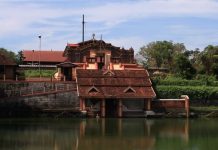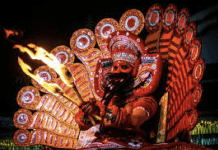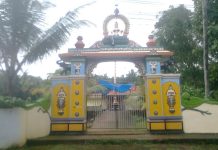Tiruvelukkai Temple (also known as Azhagiya Singar Temple) located in Kanchipuram, Tamil Nadu, is a Hindu temple dedicated to Lord Vishnu. It is one of the 108 Divya Desams dedicated to Lord Vishnu, who is worshipped as Azhagiya Singar (Narasimha) and his consort Lakshmi as Amruthavalli. The temple is glorified in the Nalayira Divya Prabandham, the early medieval Tamil canon of the Alvar saints from the 6th–9th centuries CE.
Legends
The name “Velukkai” is derived from “Vel,” meaning desire, and “irukkai,” meaning place of stay. Legend has it that this is the place where Lord Vishnu desired to stay. According to the temple’s regional legend, once there was an argument between Saraswati, the consort of Brahma, and Lakshmi, the consort of Vishnu, about superiority. Indra, the king of the celestial deities, judged Lakshmi as superior. Not satisfied with his decision, Saraswati went to Brahma, who also chose Lakshmi as the superior one. Saraswati was unhappy with the decision and decided to stay away from Brahma. Brahma did severe penance, praying to Vishnu, and performed an ashvamedha yajna. Saraswati tried to disrupt the penance in various ways, but Vishnu interfered in all her attempts. After all the demons sent by Saraswati to destroy the yajna were killed by Vishnu, she sent Kapalika, a demon. Vishnu took the form of Narhari to kill the demon.
History
Tiruvelukkai Temple is believed to have been built by the Pallavas in the late 8th century CE. Later, the Medieval Cholas and Vijayanagara kings made contributions to the temple. The temple has three inscriptions on its walls, two dating from the period of Kulothunga Chola I (1070–1120 CE) and one from that of Rajadhiraja Chola (1018-54 CE).
Architecture
Constructed in the Dravidian style of architecture, the temple has granite wall surrounds the temple, enclosing all the shrines and two bodies of water. The temple has a 3-tiered rajagopuram, the gateway tower, which is a notable feature of the temple.
The presiding deity, Narasimhar (also called Mukunda Nayaka), is depicted in a seated posture facing West. The temple has three shrines, one each for the presiding deity Azhagiya Singar, his consort Amruthavalli, and Garuda. The temple’s architecture is in the Dravidian style, with a granite wall surrounding it. The temple has a 3-tiered rajagopuram as its gateway tower.
Religious Practices
The Sri Azhagiya Singar Perumal Temple follows the traditions of the Tenkalai sect of Vaishnava tradition and follows Vaikanasa Agama. The temple priests perform the puja (rituals) during festivals and on a daily basis. As at other Vishnu temples of Tamil Nadu, the priests belong to the Vaishnava community, from the Brahmin class. The temple rituals are performed six times a day: Ushathkalam at 7 a.m., Kalasanthi at 8:00 a.m., Uchikalam at 12:00 p.m., Sayarakshai at 6:00 p.m., Irandamkalam at 7:00 p.m. and Ardha Jamam at 10:00 p.m. Each ritual has three steps: alangaram (decoration), neivethanam (food offering) and deepa aradanai (waving of lamps) for both Azhagiya Singar and Amruthavalli. During the last step of worship, nadasvaram (pipe instrument) and tavil (percussion instrument) are played, religious instructions in the Vedas (sacred text) are recited by priests, and worshippers prostrate themselves in front of the temple mast. There are weekly, monthly and fortnightly rituals performed in the temple.
Festivals
The Sri Azhagiya Singar Perumal Temple celebrates several festivals throughout the year. Here are some of the major festivals celebrated at the temple:
Vaikunta Ekadasi – December or January:
Vaikunta Ekadasi, also known as Mukkoti Ekadasi, is a major festival celebrated at the temple. The festival usually falls in December or January, and it is believed that on this day, the gates of Vaikunta (the abode of Lord Vishnu) are open for devotees. On this day, special rituals are performed at the temple, and a grand procession of the deity takes place.
Garuda Sevai – May or June:
Garuda Sevai is another important festival celebrated at the temple. The festival usually falls in May or June, and it is believed that on this day, Garuda, the mount of Lord Vishnu, visits the temple to have the darshan of Lord Aḻagiya Singar. On this day, a grand procession of the deity takes place, and devotees throng the temple to witness the event.
Thiru Aadipuram – April:
Thiru Aadipuram is celebrated in the Tamil month of Panguni (March-April). The festival is dedicated to Lord Vishnu and is celebrated with great devotion and enthusiasm at the temple. On this day, special rituals are performed, and devotees offer prayers to seek the blessings of the deity.
Hanumath Jayanthi – April or May:
Hanumath Jayanthi is celebrated to commemorate the birth of Lord Hanuman. The festival usually falls in April or May and is celebrated with great fervor at the temple. On this day, special rituals are performed, and devotees offer prayers to Lord Hanuman for strength and courage.
Temple Timings
The Sri Azhagiya Singar Perumal Temple is open for devotees from 7:00 a.m. to 11:00 p.m. and then again from 5:00 p.m. to 8:00 p.m.
How to Reach
The Alagiya Singar Temple is located in the city of Kanchipuram in the Indian state of Tamil Nadu. It is easily accessible by air, rail, and road.
By Air:
The nearest airport to Kanchipuram is Chennai International Airport, which is approximately 70 km away. From the airport, taxis and buses are available to reach the city.
By Rail:
Kanchipuram has its own railway station, which is well-connected to major cities in South India like Chennai, Bangalore, Hyderabad, and Coimbatore. Trains like Kanchipuram Express, Rock Fort Express, and Chennai Beach-Vellore Cantonment MEMU stop at Kanchipuram railway station.
By Bus/Road:
through a network of state-run and private buses. Buses from Chennai, Bangalore, and Tirupati regularly ply to Kanchipuram. The city is also well-connected to Chennai and other nearby cities through a network of national highways.
























































